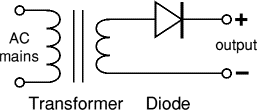This 8V DC power supply was designed for use with an expensive piece of electronic equipment. It features full over-voltage protection as a precaution against regulator failure, either in the supply itself or inside the equipment it is powering. The circuit uses a conventional full-wave rectifier, followed by a 3-terminal voltage regulator (REG1) with appropriate filtering. When power is applied and switch S1 is in the “Run” position, REG1’s output is fed to the load via a 500mA fuse and Schottky diode D3.
This also lights LED2 (yellow) and LED3 (green), which respectively indicate the presence of the unregulated and regulated voltages. D3 is there to protect the circuit against external voltage sources (eg, charged capacitors). A “crowbar” circuit comprising ZD1 and SCR1 provides the over-voltage protection. It works like this: if a fault develops (eg, REG1 short circuit) which causes the output voltage to rise above 9.1V, ZD1 turns on and applies a voltage to the gate of SCR1
Circuit diagram:
Figure 1 8V DC Power Supply With Over-Voltage Protection Circuit Diagram
If the voltage then continues to rise, SCR1 turns on (at about 10V) and “blows” the fuse. Zener diode ZD2 provides emergency over-voltage protection in case the “crowbar” circuit develops a fault. Switch S1 is provided so the operator can occasionally test the “crowbar” function. When S1 is switched to the “Test” position, the load is disconnected by S1b and the unregulated supply voltage is applied by S1a to the “crowbar” circuit, thus causing it to trigger. When this happenS, LEDs 2 & 3 (green and yellow) extinguish and LED1 (red) lights to indicate that the SCR has triggered. The SCR turns off again when S1 is switched back to the “Run” position.
Author: L. Cox – Copyright: Silicon Chip Electronics



















